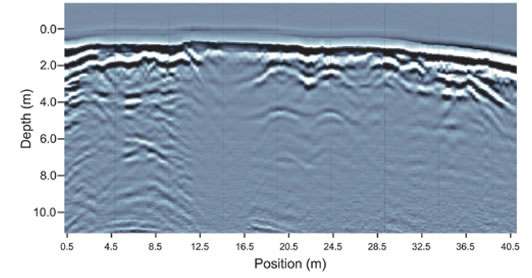urial mounds, tombs and associated structures of varying age exist world wide and are of great historic interest. The present study is a snap shot of an on-going investigation of the Rathcroghan mound believed to be the burial site for Queen Maud in Ireland. Digital topography and GPR data are combined with gradiometer magnetics to define the internal structure in an Irish burial mound.
Problem
Evaluation of historical sites is always hampered by the lack of factual information. While excavation is permitted in some cases, many sites do not permit intrusive investigations of any sort since exposure may lead to rapid site and buried artifact degradation. Further, the time and cost of extensive excavation is large. The need for techniques that provide rapid area coverage and detailed imaging of the subsurface naturally leads to exploiting the power of GPR.
GPR Contribution to Solution
A demonstration GPR survey was conducted on the Rathcroghan mound in 1994. At this time very little was known. Time on site was limited and relatively high attenuation soils were present. The grass on the site was uncut making movement difficult.
A 100 MHz pulseEKKO IV GPR was deployed in step mode. A series of parallel lines were surveyed with line spacing of 2 m. Since there was a priori basis for the survey location, an area covering the top of the mound as well as limited transects over the whole mound were carried out in the hopes of finding structure that could be followed up in more extensive mapping.
The GPR cross sections showed some very interesting features but there was no control on the possible source of the responses. Subsequent to this initial GPR work, detailed magnetic gradiometer mapping and other work such as digital topographic mapping have been completed. The older GPR data were reprocessed using EKKO_Mapper software to build depth slices for correlation with the magnetic data.
As with most archeological investigations, getting to the end of the story seldom happens completely. Piece by piece an understanding of a site slowly builds up. The story of Rathcroghan is still ongoing.
Reference:
J. Waddell and K. Barton, 1995, Seeing Beneath Rathcroghan, Early Christian to Medieval. Page 38-41 New and Bargain Books



Results & Benefits
The above study demonstrates the value of GPR for archeological investigation. Some key observations are:
- GPR detects a wide range of potential targets but ground truth is critical in ascertaining the proper explanation of the GPR data.
- Rough surface conditions demanded slower step mode data acquisition
- Attenuation and access required low frequency GPR making for deeper penetration but lower spatial resolution data.
- Acquiring multiple sensor data can help the understanding of site conditions as the magnetic and GPR images demonstrate.
Download the case study: GPR for Irish Mound Archeology Site Survey
Click here to learn more about pulseEKKO PRO Ground Penetrating Radar.
GPR responses vary greatly depending on the target being sought and the host material. GPR response variability can be challenging to new GPR users. When learning about GPR, the best practice is to review several similar GPR case studies to develop an understanding of variability. Check for other insightful information on the resources tab to learn more.
Use Contact Us to reach our Application Specialists who can help you tap into Sensors & Software’s vast array of technical information.








